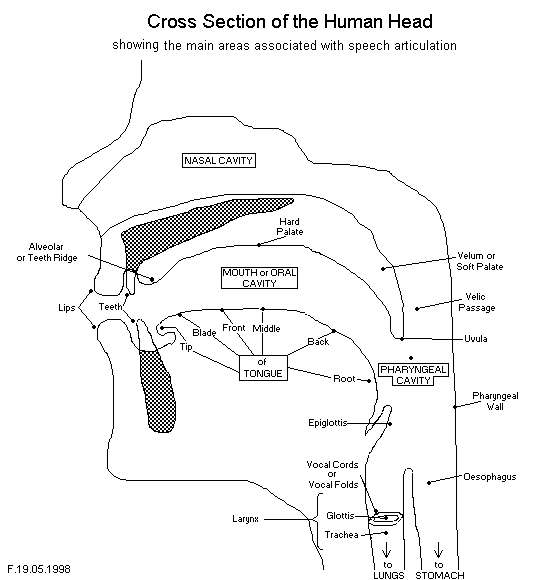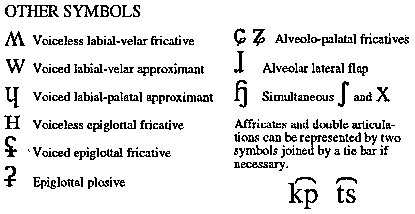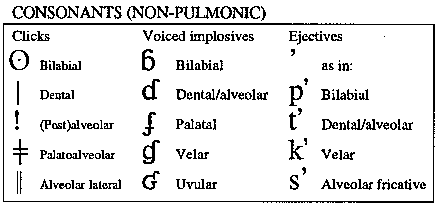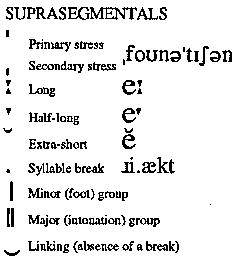A Layman's Guide to
Phonology and
IPA
(International Phonetic Alphabet)
Phonology is the study of pronunciation, in the "what" and "how" we make sounds. The apparatus are the organs which are used for speech, from the diagphram and lungs, and into the mouth to the outside of the body. In making sounds, we can concentrate on the region of the head and neck. The airstream mechanism is how the air is moved during speech. The nature in which the air is impeded along the way is known as articulation. Air which originates in the lungs is known as pulmonic air, and its direction outwards is termed egressive, so in normal speech the air-stream is pulmonic egressive. It is possible for sounds to be made with air from the oral cavity. Closing the back of the throat, and pursing the lips with a mouthful of air, draw back the tongue, whilst moving the mass of the tongue forward and contracting the cheeks, the air is forced out of the pursed lips, making a noise by the rapid opening and closing of the lips. Clicking with the tongue also makes a noise. These are known as oral airstreams mechanisms. Air which moves into the body to produce sounds is known as ingressive air. It is possible to speak by making the air go into out lungs, rather than out of it. However, you'll soon find that speaking egressively is much easier than ingressively for long periods of time.

The diagram above shows a cross section of the human head and various parts of the aparatus used in the production of human speech. Another air mechanism known as pharyngeal or throat air can be made by moving air in this region. Often, oral and pharyngeal are given the names velaric and glottalic respectively.
Organs
The cross section of the head above shows the organs that are used in the production of speech. The lips, tongue and velum can be moved at will, and known as the elastic organs. The movement of these, together with the airstream, aids in the production of human speech sounds. There are alternative names for these areas as follows.
- Lips - labia
- Labial - using the lips
- Dental - teeth
- Alveolar Ridge - teeth ridge
- Palate - hard palate
- Palatal - using the hard palate
- Velum - soft palate
- Velar - using the velum
- Glottal - using the glottis
- Mouth Cavity - Oral Cavity
- Trachea - windpipe
Voicing
Voicing is the actual vibration of the vocal cords. Consonants can be classed into two categories, voiced and unvoiced. Compare the consonant at the beginning of the sounds: pair and bare; tail and dale; kiddy and giddy; sue and zoo, few and view.
You can sense the vibrations in two ways. The first is to feel the area where your vocal cords are during the production of these sounds. The other way involves closing the ears to the outside by covering them up with one's hands.
By pronouncing them in a bold manner, and slowly, we can sense that the second of the two in the pair vibrate the vocal cords. Letters, p, t, k, s, and f are unvoiced because the vocal cords do not vibrate when articulating the sounds, however, b, d, g, z, and v do vibrate the vocal cords and so they are voiced. Note for each pair, the sounds are pronounced for the first and second in the same area in the mouth: p,b; t,d; k,g; s,z; f,v. Only the voices distinguishes the two sounds in each case.
There is also another way to distinguish a voiced and voiceless sound. Voiced consonants can be made to carry on long after their initial pronunciation, whilst unvoiced consonants can not. Try saying the following :
pppppppppppp, bbbbbbbbbbb
tttttttttttt, ddddddddddd
kkkkkkkkkkkk, ggggggggggg
ssssssssssss, zzzzzzzzzzz
ffffffffffff, vvvvvvvvvvv
Aspirating
Aspiration occurs when there is an audible exhalation of breath. For instance, pine has an aspirated p, written ph, and spine is unaspirated, written with o beneath the p. In general, the listener hears for p, t, and k, the unaspirated version b, d and g when they are preceeded by s in English. Compare pill, till and kill, with spill, still and skill. Since both the unaspirated and aspirated p consonants are actually different forms of one another, they are called allophones.
Representation
If we write English bough, rough, ought, and though, the letters "ough" has a different sound in each case. Similarly, the English words "caught", and "precious" has different sounds represented by the letter c. Clearly then, English letters cannot be used effectively to represent sounds unambiguously. We can extend this also to each and every other alphabetical system in existence. How then to transcribe a sound which is unambiguous and yet accurate? We need the use of an International Phonetic Alphabet.
I.P.A.
International Phonetic Alphabet
In order to record the sounds of human speech, we must devise a method which is roughly independent of the usual spellings in languages. First we shall look at the vowels. They are produced by varying the position of the tongue, and voicing the sounds which resonate in the area above the larynx and in the mouth. The IPA table of pulmonic consonants - consonants pronounced using air from the lungs follows and then other miscellaneous symbols.
IPA Vowels :
IPA Consonants :
Other Symbols
Vowels

Vowels
These are made with the aid of the tongue. Its positioning in the mouth affects the sound produced. All vowels are voiced in ordinary speech. It is often the most prominent sounds we hear.
The shape of the diagram is representative of the postion the tongue takes when pronouncing these vowels. Front, central and back refer to the place where these vowels occur along the tongue. Open and close (close as in the sense of 'being near to') and the ranges in between represent the height of the tongue from the mouth's palate. (Since the tongue is never obstructed during the production of a vowel it is never 'closed' in the sense of an obstruction by the tongue.)
The shape of the lips further subdivides and catalogues the sounds as shown above. A rounded vowel is one where there is rounding of the lips. The other type is known as unrounded vowels where there is some degree of lip spreading.
Pure Vowels are those shown in the above chart. When two vowels come together and there is movement in the tongue which differs from the intial to the final position, it is known as a dipthong. Naturally by this definition tripthongs would involve three vowels and hence three tongue positions.
Consonants

There are a few sounds which have not been covered in the above table. Other terms used are
Affricate :
Lateral :
Semi-Vowel :
Liquids
Place of Articulation
Bilabial
Articulated by the two lips.
( IPA )
Labiodental
Articulated using the top lip against the lower
( IPA )
Dental
Articulated using the tip of the tongue against the upper teeth.
( IPA )
Alveolar
Articulated using the tip or blade of the tongue against the alveolar ridge, (also known as the teeth ridge).
( IPA )
Retroflex
Articulated by the tip of the tongue against the hard palate.
( IPA )
Postalveolar
Articulated by the tip of the tongue against the back part of the teeth ridge.
( IPA )
Palatal
Articulated by the "front" (not the blade or tip) of the tongue against the hard palate.
( IPA )
Velar
Articulated by the back of the tongue against the central and forward part of the soft palate.
( IPA )
Uvula
Articulated by the back of the tongue against the extremity of the soft palate.
( IPA )
Pharyngeal
Articulated by the constriction of the pharynx between the root of the tongue and the wall of the pharynx.
( IPA )
Glottal (or Laryngeal)
Articulated in the glottis - e.g. the glottal stop.
( IPA )
Manner of Articulation
Plosive
Formed by complete closure of the air-assage during an appreciable time; the air is compressed (generally by the action of the lungs) amd on release of the closure issues suddenly, making an explosive sound or plosion.
( IPA )
Nasal
Formed as a complete closure in the mouth, the soft palate being, however, lowered so that the air is free to pass through the nose.
( IPA )
Trill
Also called Rolled, formed by a rapid succession of taps of some elastic organ
( IPA )
Tap or Flap
Formed by the ingle tap of some elastic organ; the position of contact is not maintained for any appreciable time.
( IPA )
Fricative
Formed by narrowing the air-passageto such an extent that the air in escaping produces audible friction (i.e. some kind of hissing sound).
( IPA )
Lateral Fricative
Formed by placing an obstacle in the centre of the air-channel but leaving a free passage for air on one or both sides of the obstacle, and narrowing the air passage to the extent of producing audible friction, (i.e. hissing with a blocking of the middle of the air-passage).
( IPA )
Approximant
Also known as a Frictionless Continuant, made with the organic position of a fricative consonant, but pronounced with weak breath-force so that no friction is heard. (The palatal and velar frictionless continyants have the organic positions of close (as in near) vowels. They are, however, uttered with very little breath-force as compared with the normally pronounced vowels which adjoin them in connected speech. These frictionless continuants are to be considered as consonants on account of their consequent lack of prominence as compared with the adjoining vowels.)
( IPA )
Lateral Approximant
Formed by the Lateral and Approximant manners of articulation, ie, made by an obstruction in the air-passage, and produced with no friction, with a weak breath force.
( IPA )
Affricate
Formed by as plosive consonants, but with slower separation of the articulating organs, so thatthe corresponding fricative is audible as the separation takes place.
( IPA )
Lateral
Formed by placing an obstacle in the centre of the air-channel, but leaving a free passage forthe air on one or both sides of the obstacle.
( IPA )
Semi-Vowel
Also known as a Glide, a voiced gliding sound in which the speech organs atart producing a wakly articulated vowel of comparatively small inherent sonority and immediately changed to antother sound of equal or greater prominence.
( IPA )
Liquids
Consonants which can be held on continuously without change of quality are sometimes classed together as contunatives or continuantsl they include nasal, lateral, rolled, fricative consonants and frictionless sounds. Nasal lateral and rolled consonants are sometimes classed together under the not very satisfactiory name Liquids. (Some authors do no include nasal consonants among "liquids".)
( IPA )
Consonants (Pulmonary)
p (voiced bilabial plosive consonant) peer, spear, peep
( IPA )
b (voiced bilabial plosive consonant) beak, drab
( IPA )
t (unvoiced alveolar plosive consonant) tar, star, cart
( IPA )
d (voiced alveolar plosive consonant) dark, card
( IPA )
t_ (unvoiced retroflex plosive consonant)
( IPA )
d_ (voiced retroflex plosive consonant)
( IPA )
c (unvoiced palatal plosive consonant)
( IPA )
_f (voiced palatal plosive consonant)
( IPA )
k (unvoiced velar plosive consonant) king, skill, book, cool, truck
( IPA )
g (voiced velar plosive consonant) gill, big
( IPA )
q (unvoiced uvular plosive consonant)
( IPA )
G (voiced uvual plosive consonant)
( IPA )
? ( glottal stop or glottal plosive consonant) what > wot?
( IPA )
m (voiced bilabial nasal consonant) member, simmering
( IPA )
mg (voiced labiodental nasal consonant)
( IPA )
n (voiced alveolar nasal consonant)
( IPA )
n_ (voice retroflex nasal consonant)
( IPA )
_n (voiced palatal nasal consonant)
( IPA )
ng (voiced velar nasal consonant)
( IPA )
N (voiced uvula nasal consonant)
( IPA )
B (voiced bilabial trill consonant)
( IPA )
r (voiced alveolar trill consonant)
( IPA )
R (voiced uvula trill consonant)
( IPA )
r~ (voice alveolar tapped consonant)
( IPA )
£ (voiced retroflex tapped consonant)
( IPA )
F (unvoiced bilabial fricative consonant)
(
IPA )
_B (voiced bilabial fricative consonant))
( IPA )
f (unvoiced labiodental fricative consonant)
( IPA )
v (voiced labiodental fricative consonant)
( IPA )
0th (unvoiced dental fricative consonant)
( IPA )
dth (voiced dental fricative consonant)
( IPA )
s (unvoiced alveolar fricative consonant)
( IPA )
z (voiced alveolar fricative consonant)
( IPA )
sh (unvoiced post-alveolar fricative consonant)
( IPA )
z3(voiced alveolar fricative consonant)
( IPA )
s\
( IPA )
z\
( IPA )
c,
( IPA )
j-
( IPA )
x
( IPA )
V
( IPA )
X
( IPA )
_R
( IPA )
h-
( IPA )
|?
( IPA )
h
( IPA )
h^
( IPA )
l@
( IPA )
lz
( IPA )
uv
( IPA )
_|r
( IPA )
_|r_
( IPA )
j
( IPA )
w|
( IPA )
l
( IPA )
l_
( IPA )
_y
( IPA )
L
( IPA )
Other Symbols





© Dylan W.H. Sung, except where otherwise noted.
The diagram of the head crossection was finished in May 19th 1998, and this page was begun on Sunday 18th October 1998.
The diagram of pulmonic consonants is taken from the IPA page at http://www.arts.gla.ac.uk/IPA/fullchart.html.
Text references:






